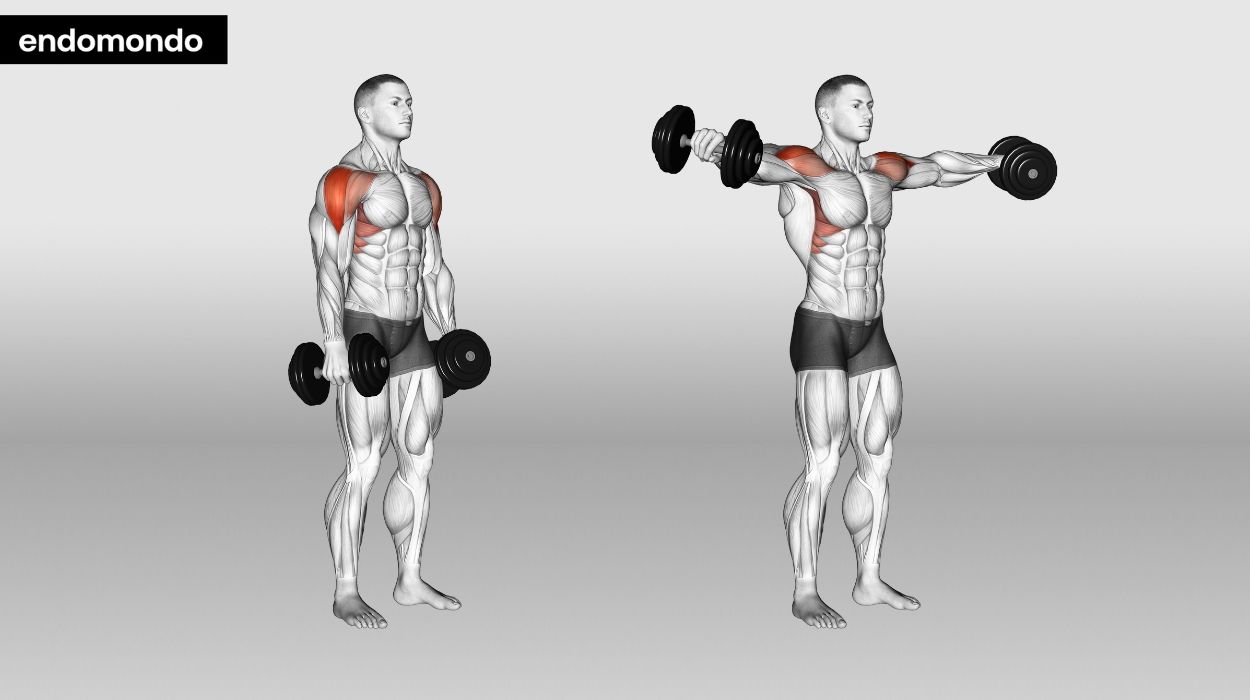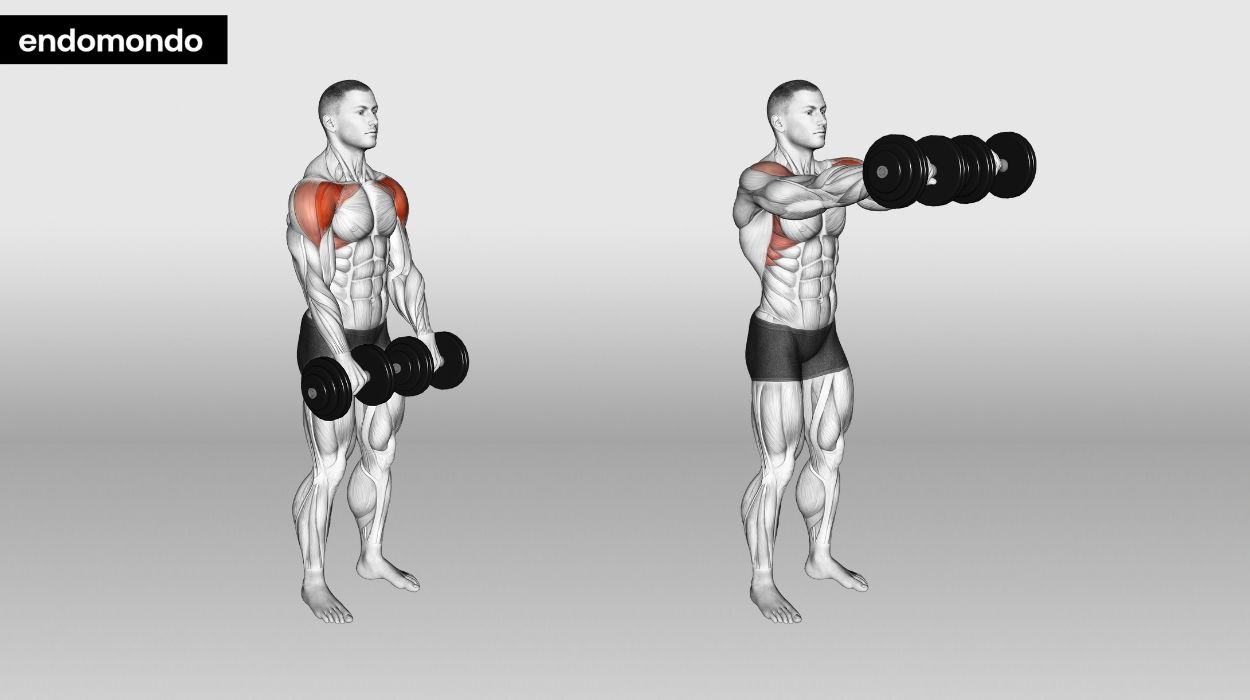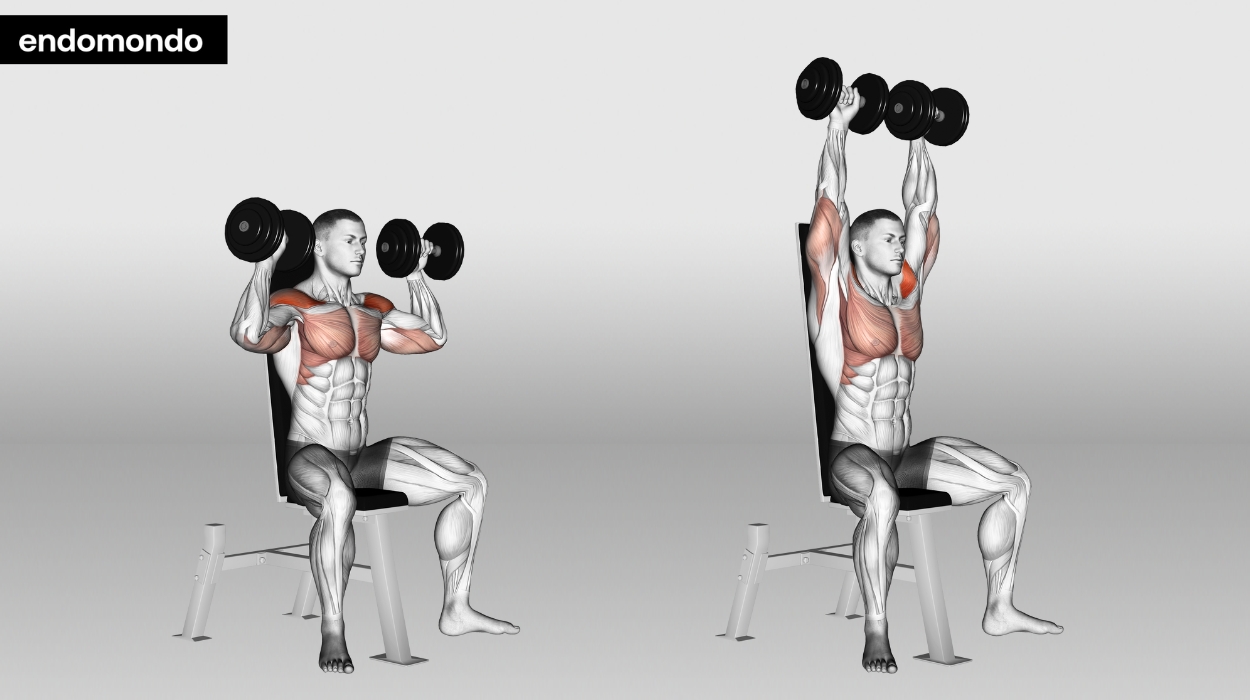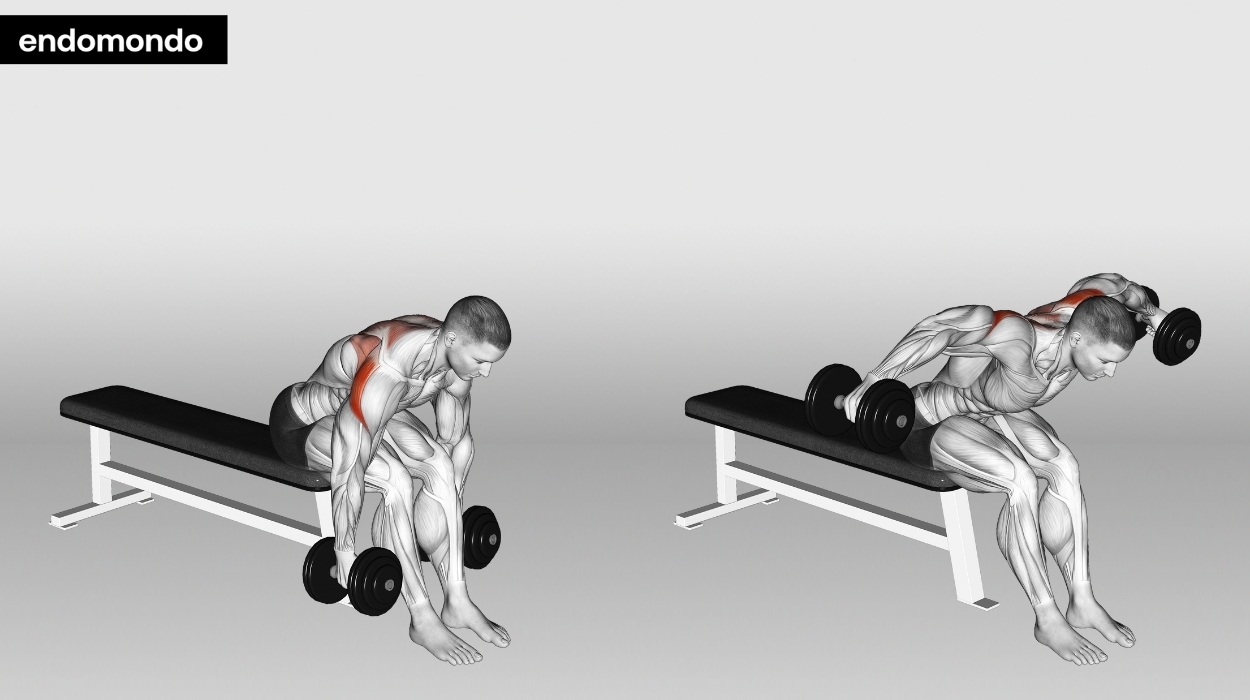
If you’re interested in building muscle and improving your physical appearance, you’ll want to consider exercising your shoulders. Engaging in an at-home shoulder workout can be beneficial because muscle strength, flexibility, and mobility [1] will be enhanced. This will give you the edge you need to boost your physical training, and it also supports your neuromuscular capabilities and motor control.
Beyond a fit appearance, many health benefits accompany an effective arm and shoulder workout. In addition to toning your physique, you may also notice that you’re standing up straighter, there may be less strain on your back, and your everyday chores are easier to accomplish. Not only can you reap these benefits, but you may also experience efficient fat-burning, cardiovascular enhancements, and greater mobility.
Best Shoulder Workout You Can Do At Home 2024
The following exercises will help strengthen the muscles of the shoulders, promote good posture, and aid in overall functionality:
At-Home Shoulder Workout: Five Exercises 2024
Globally, there has been an advent in the engagement of home workouts, and this has increased the sentiment of taking control of health and fitness. You may feel safer at home, don’t wish to pay for a gym membership, or just don’t have the time to devote to the gym consistently.
Creating a space in your home to exercise can benefit your morale and health. We will discuss the importance of doing at-home shoulder workouts as well as how to execute these workouts to maximize the benefits safely.
Standing Dumbbell Lateral Raise

The Standing Dumbbell Lateral Raise is a great addition to your push-day workout routine. This upper-body exercise can enhance your shoulder muscles [2] while specifically targeting the deltoids. Consistency with this exercise will result in overall muscle growth and toning of your upper body.
In addition to muscle growth and definition, this type of workout can provide some protection and functionality for your bones. The risk of bone-related injuries will be lowered, and your upper body balance will be improved. This provides support to your posture and any weight-bearing activities.
Lateral raises [3] involve bending and leading with the elbows to keep the focus on the intended muscles. If your arms are straightened out, like a frontal raise, there will be greater tricep activation than you aim for. Lateral raises are usually based on isolations geared toward the deltoids.
How to do:
- Stand up with your knees slightly bent and your feet hip-width apart.
- Begin with a dumbbell in each hand and position your arms straight down at your sides. This is the starting position.
- While keeping a slight bend in your elbows, slowly raise your dumbbells until they align with your shoulders.
- Pause here for a moment before lowering the dumbbells back to the starting position.
Tips:
- Warm up before working out to reduce post-workout soreness.
- Maintain proper form for effectiveness and safety.
- Keep your elbows slightly bent to avoid straining the shoulder muscles.
- Increase your load over time.
Optimal Sets & Reps: Complete 3 sets of 10 repetitions.
Standing Dumbbell Front Raise

The Standing Dumbbell Front Raise is an excellent arm and shoulder workout. With this workout, you can maximize the calories you burn to sustain an ideal weight and to help with muscle mass. Additionally, you’ll see metabolic boosts through upper-body workouts and aerobic activities.
Engaging in this exercise can also increase your shoulder stability. This can improve your mobility, which helps with range of motion and flexibility. This will allow you to carry out your tasks more efficiently and easily without the threat of declining posture or chronic pain.
The frontal raises may be a greater challenge than lateral raises because you’ll need better stability to maintain proper form. The muscles along your trunk may be engaged as well, so you’ll want to use a lighter set of dumbbells compared to those used in lateral raises.
How to do:
- Begin in the starting position with your knees slightly bent as your arms hang before you.
- Position your palms toward you as you hold the dumbbells.
- Raise your arms before you, ensuring they remain in a straight line.
- Pause when your arms are parallel to the floor, then slowly return your dumbbells to the starting position.
Tips:
- Start your front raises with a weight that is lighter than what you used for lateral raises.
- Like the lateral raises, only increase your load when you’ve built up your strength.
- Keep your arms straightened throughout to maximize the results of this exercise.
Optimal Sets & Reps: Complete 4 sets of 10 repetitions.
Seated Dumbbell Shoulder Press
Other great at-home workouts include dumbbell shoulder exercises like the Seated Dumbbell Shoulder Press. This exercise is very common due to its reliable effectiveness. Because of the stability required to perform this exercise, it can activate the front, lateral, and rear delts at once.
Consistently including this simple exercise in your regimen can help you develop your muscles and build strength in your shoulders and arms.
A classic exercise like this one serves as a great foundation because growing strength will enable you to lift heavier loads, aim for more challenging workouts, and sculpt a more toned body. Not only will you have an aesthetically appealing form, but you’ll be protecting your joints from injury and preserving your mobility.

How to do:
- Begin in the starting position by sitting upright on a bench with your back and head pressed against the pad.
- Once the dumbbells are in your hands, lift them to shoulder height so your dumbbells and shoulders align in the same position. Your palms should be facing forward.
- Take a breath as you brace your core for pressing.
- Press by raising your arms straight up above your head for a full arm extension, exhaling as you do so.
- Inhale again as you lower your dumbbells back down to shoulder level.
Tips:
- Utilize the appropriate weights and form when doing shoulder workouts at home.
- Aim for five reps to build strength and eight to twelve reps to build muscle.
- Always do warm-ups to allow for greater flexibility.
Optimal Sets & Reps: Complete 4 sets of 10 repetitions.
Seated Dumbbell Rear Delt Fly
The Seated Dumbbell Rear Delt Fly is a great example of rear delt exercises to include in your regimen. The abduction training [4] of this exercise helps you to give the posterior segment the attention it deserves.
Always make sure you’re lifting the same load between your left arm and right arm because this works to reduce muscular imbalances.[5]
As you do this workout, the position of your body and arms can help correct your posture. It may also allow for consistent support from the front of the body to the back. This will be vital for people who spend most of the day slouching or hunched over a computer.
Rear delt flyes can also be done as cable shoulder workouts. Doing cable rear delt flyes could give the same effect to your posterior deltoid muscle and may be preferred by some.

How to do:
- In the starting position, sit down on a bench, leaning forward at your hips as you do so.
- Keeping your spine neutral and shoulder blades back, allow your arms to hang down towards the floor on either side of your legs. Grip a dumbbell in each hand, and have your palms facing each other.
- With slightly bent elbows, bring your dumbbells up and out at the sides in a flying motion.
- Continue this motion until the upper arms are parallel to the floor.
- Finally, lower your arms back down to your initial position.
Tips:
- Do these exercises slowly with great control as you bring your dumbbells back down.
- Keep your breathing steady as you do your flies.
- Make sure your torso stays stable throughout the workout.
Optimal Sets & Reps: Complete 4 sets of 12 repetitions.
Standing Dumbbell Y Raise
Last but certainly not least is the Standing Dumbbell Y Raise. This workout has often been done as a variation of chest workouts at home with dumbbells, like the inclined bench press.
The Dumbbell Y Raise is a great upper body workout that engages the rear delts and your upper back muscles, like the traps and rhomboids. As you stand to do this exercise, you activate your core, making this beneficial for the upper body overall.
How to do:
- Ease into a stance with your feet shoulder-width apart in the starting position. Hinge forward slightly at your hips and brace your core.
- Hold a dumbbell in each hand with your palms facing each other.
- With a slight bend in your elbows, raise your dumbbells so your elbows align with your ears.
- As you lift the dumbbells, your arms should be at an angle between the front raise and the lateral raise. This is what makes the Y shape.
- Finish by lowering your dumbbells back to your starting stance before repeating for the desired number of reps.
Tips:
- Avoid arching or extending your back, as you want to maintain a neutral spine.
- Keep your shoulders down, and avoid raising or shrugging them.
Optimal Sets & Reps: Complete 4 sets of 12 repetitions.
Health Benefits Of At-Home Shoulder Workouts
Increases Functionality
Strengthening your shoulders means you’ll be able to lift more weights and work out with heavier loads. This also improves your ability to do anything from lifting a baby to moving your furniture around. Having a better range of motion and flexibility in your movements means you’ll be able to do daily tasks and sports-related activities without strain.
Skeletal Support
As these workouts increase your strength, you will also be afforded neuromuscular support.[6] Sculpting your body will tone your back muscles, which also means your shoulders will be stronger and become more relaxed, thus eliminating poor posture. Improved posture gives your upper body the support it needs, as this provides healthy alignment and stability.
Protection Against Injuries
With an improved ability to carry out tasks and better strength to support this, you’ll also be protecting yourself from injuries.[7] Upper body strength can guard you from strain, injuries, and fractures accompanying chronic pain.
Metabolic Boost
A combination of aerobic and anaerobic resistance workouts can bolster your endurance and better equip you for athletic performances.[8] Additionally, training your shoulders and your arms can help you to burn calories, even when resting. Not only do you get excellent cardiovascular exercise, but you’ll be burning fat and toning your body in the process.
Warm-Up Tips For At-Home Shoulder Workouts
A proper warmup encourages synovial fluid, which increases the mobility of your joints and reduces the risk of injury. Additionally, you’ll want to address adequate form and load, as the proper execution is necessary before you add weight. Increase your loads gradually as you build up strength.
Conclusion
Taking advantage of chest and arm workouts will improve your upper body strength and total body health in no time. Working these muscle groups together can optimize your fitness and wellness.
This kind of regimen will allow you to meet and sustain any weight loss goals that you’ve set. The emphasis on your shoulders will bolster your flexibility, range of motion, and day-to-day functionality.
Frequently Asked Questions
Try working out at least two times weekly. Two weekly sessions can promote muscle growth better than just one session, but you also don’t want to exercise excessively.
The Seated Dumbbell Shoulder Press may be one of the best at-home shoulder workouts. This exercise effectively targets the shoulders while demanding an engaged core.
You can build shoulder muscles by doing pushups. Doing this activity will activate your upper body’s push muscles and help build muscle mass.
Pushups are an effective addition to your push-day regimen. This will upgrade your blood flow and prime your muscle groups. Doing pushups can work the anterior muscles of the shoulder and promote definition, strength, and upper-body fitness.
Your muscles need time to rest and recover in between workouts. Work your shoulders one to two times per week, and always allow for a day of rest in between.
Resources
- Salles, J.I., Velasques, B., Cossich, V., Nicoliche, E., Ribeiro, P., Amaral, M.V. and Motta, G. (2015). Strength Training and Shoulder Proprioception. Journal of Athletic Training, [online] 50(3), pp.277–280. doi:https://doi.org/10.4085/1062-6050-49.3.84.
- Rabello, R., Bertozzi, F., Hauschild de Freitas, I.L., Molinari, T., Roncada, C., Sforza, C., Rodrigues, R. and Tiggemann, C.L. (2022). Activation of the three deltoid muscle portions during common strengthening exercises: A systematic review. Journal of Bodywork and Movement Therapies. doi:https://doi.org/10.1016/j.jbmt.2022.12.002.
- Coratella, G., Tornatore, G., Longo, S., Esposito, F. and Cè, E. (2020). An Electromyographic Analysis of Lateral Raise Variations and Frontal Raise in Competitive Bodybuilders. International Journal of Environmental Research and Public Health, 17(17), p.6015. doi:https://doi.org/10.3390/ijerph17176015.
- Yang, Z., Xu, G., Yang, J. and Li, Z. (2023). Effect of different loads on the shoulder in abduction postures: a finite element analysis. Scientific Reports, [online] 13(1), p.9490. doi:https://doi.org/10.1038/s41598-023-36049-9.
- Abdelraouf, O.R., Ebrahim, M.Y., Abdel-aziem, A.A., Abdel-Rahman, S.M., Yamani, A.S. and El Askary, A.A. (2022). Isokinetic Assessment of Shoulder Joint Strength Ratios in Male Recreational Weightlifters: A Cross-Sectional Study. Applied Bionics and Biomechanics, 2022, pp.1–8. doi:https://doi.org/10.1155/2022/6106943.
- Baritello, O., Khajooei, M., Engel, T., Kopinski, S., Quarmby, A., Mueller, S. and Mayer, F. (2020). Neuromuscular shoulder activity during exercises with different combinations of stable and unstable weight mass. BMC Sports Science, Medicine and Rehabilitation, 12(1). doi:https://doi.org/10.1186/s13102-020-00168-x.
- El Assar, M., Álvarez-Bustos, A., Sosa, P., Angulo, J. and Rodríguez-Mañas, L. (2022). Effect of Physical Activity/Exercise on Oxidative Stress and Inflammation in Muscle and Vascular Aging. International Journal of Molecular Sciences, 23(15), p.8713. doi:https://doi.org/10.3390/ijms23158713.
- Gillen, Z.M., Wyatt, F.B., Winchester, J.B., Smith, D.A. and Ghetia, V. (2016). The Relationship Between Aerobic and Anaerobic Performance in Recreational Runners. International journal of exercise science, [online] 9(5), pp.625–634. Available at: https://www.ncbi.nlm.nih.gov/pmc/articles/PMC5154721/#:~:text=Research%20has%20indicated%20that%20combined.




